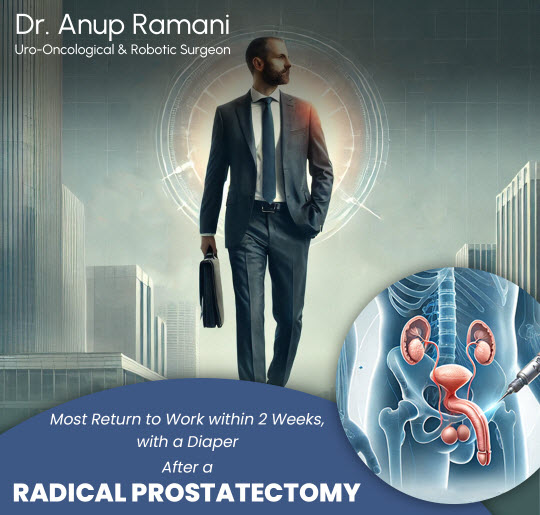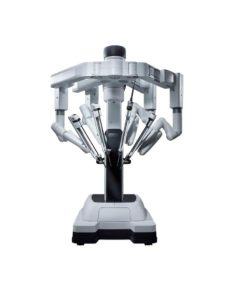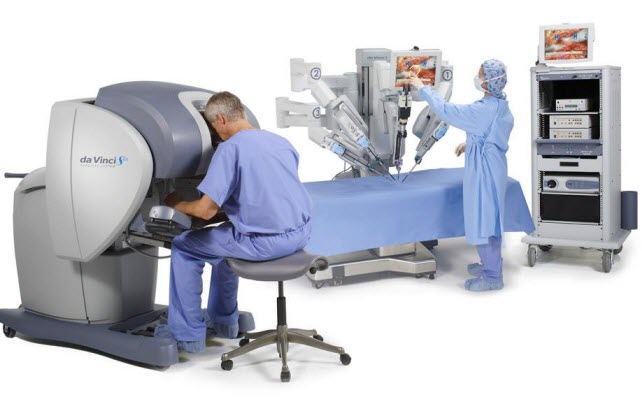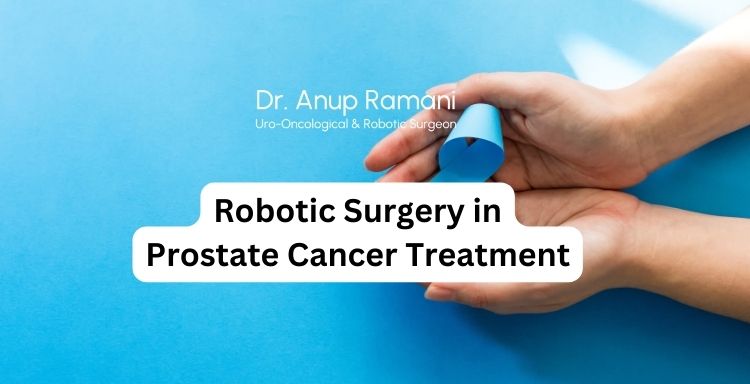Dr Anup Ramani @ Copyright 2024
By Dr. Anup Ramani
The Rise of Robotic Surgery in Prostate Cancer Treatment
Benefits of Robotic Surgery for Prostate Cancer
1. Minimal Invasive Procedure
One of the most significant advantages of robotic-assisted surgery is that it is a Minimal Invasive Surgery for prostate cancer. Unlike open prostatectomy, which requires a large incision, robotic surgery involves only a few small incisions. This reduces the risk of infections and shortens the recovery period.
- Reduced Blood Loss: Smaller incisions mean less blood loss during surgery, which decreases the likelihood of needing a blood transfusion.
- Less Post-Operative Pain: Patients report experiencing less pain, allowing them to resume daily activities sooner compared to traditional surgery methods.
2. Enhanced Precision and Control
The robotic system gives Prostate Cancer Surgeons the ability to operate with a high degree of control and precision. The advanced robotic arms are equipped with 3D high-definition cameras that provide a magnified view of the surgical site.
- Better Visualization: The enhanced imaging allows surgeons to clearly see nerves and tissues surrounding the prostate, minimizing damage and preserving important structures, such as nerves responsible for urinary and sexual functions.
- Accuracy in Tumor Removal: Robotic arms filter out any tremors, ensuring that even the smallest movements are precise. This accuracy is crucial for successfully removing cancerous tissues while sparing healthy areas.

Reducing Complications Through Robotic Surgery
1. Lower Risk of Incontinence
Urinary incontinence is a common complication following Prostate Cancer Surgery. However, robotic-assisted surgery significantly lowers this risk. The precision of the robotic instruments allows surgeons to better preserve the urinary sphincter, which is crucial for maintaining bladder control.
- Quick Recovery: Most patients experience a faster return to normal bladder function.
- Minimized Long-Term Effects: Robotic surgery techniques reduce the likelihood of long-term incontinence issues, enhancing the quality of life for patients.
2. Improved Sexual Function
Another major concern for prostate cancer patients is the risk of erectile dysfunction. The nerves responsible for sexual function are located very close to the prostate, making them susceptible to damage during surgery. Robotic-assisted procedures offer a higher chance of nerve preservation.
- Nerve-Sparing Techniques: With robotic surgery, the surgeon can perform nerve-sparing techniques more effectively, which helps in maintaining sexual function.
- Enhanced Post-Surgical Outcomes: Studies show that patients who undergo robotic surgery have a higher likelihood of regaining their sexual function compared to those who opt for traditional surgeries.
Why Choose Robotic Surgery for Prostate Cancer in India?
India has emerged as a leading destination for medical tourism, particularly for cancer treatments. Patients from all over the world seek Prostate Cancer Surgery in India due to its combination of advanced technology and affordable healthcare. Here are some reasons why India is a preferred choice:
1. Expertise of Indian Surgeons
Indian Prostate Cancer Surgeons are known for their expertise and experience in performing robotic-assisted surgeries. The country’s medical professionals are trained in leading international institutions, ensuring they are well-versed in the latest surgical techniques.
- Internationally Acclaimed Surgeons: Many Prostate Cancer Surgeons in India have extensive experience and are recognized globally for their contributions to the field.
- Continuous Training and Research: Indian surgeons regularly update their skills through training and research, making them pioneers in robotic prostate surgery.

2. Cost-Effectiveness
The cost of Prostate Cancer treatment in India is significantly lower than in Western countries. Despite the affordability, the quality of care remains top-notch.
- Affordable Treatment Packages: Patients can save up to 60-80% on medical expenses compared to countries like the United States or the UK.
- World-Class Facilities: Hospitals in India are equipped with state-of-the-art robotic systems and adhere to international healthcare standards.
Understanding the Procedure: How Robotic Prostate Surgery Works
The robotic prostatectomy procedure involves several key steps:
1. Patient Preparation and Anesthesia
The patient is placed under general anesthesia to ensure comfort throughout the surgery. The Prostate Cancer Surgeon then makes a few small incisions in the abdomen to insert the robotic instruments.
- Instruments and Camera Placement: The robotic arms, along with a 3D camera, are inserted through these incisions. The camera provides a high-definition, 360-degree view of the surgical area.
- Patient Safety Measures: Advanced monitoring systems are in place to track the patient’s vitals and ensure a smooth procedure.
2. Performing the Surger
The surgeon controls the robotic arms from a console. Each arm mimics the movements of the surgeon’s hands but with far greater precision.
- Removal of the Prostate Gland: The surgeon carefully removes the prostate gland and nearby cancerous tissues while preserving as many healthy tissues as possible.
- Nerve-Sparing Techniques: If the cancer has not spread to the surrounding nerves, the surgeon can use nerve-sparing techniques to protect sexual and urinary functions.
3. Post-Operative Care and Recovery
The Minimal invasive nature of robotic surgery leads to faster recovery times. Most patients can go home within 24 to 48 hours and resume normal activities within a few weeks.
- Follow-Up Care: Post-surgery, patients undergo regular follow-ups to monitor their recovery and ensure there are no complications.
- Physical Therapy: Some patients may benefit from pelvic floor exercises to further improve urinary control and sexual function.

Future of Robotic Surgery in Prostate Cancer Treatment
As technology advances, the role of robotic-assisted surgery in treating prostate cancer is only expected to grow. Innovations such as artificial intelligence (AI) and machine learning may further improve surgical outcomes and reduce complications.
- Improved Surgical Training: Simulation-based training for Prostate Cancer Surgeons is becoming more common, allowing them to perfect their skills before operating on real patients.
- Potential for Personalized Treatment: Future advancements may make it possible to tailor robotic surgeries even more specifically to each patient’s anatomy and cancer stage.
Conclusion
Robotic surgery has transformed the way we approach Prostate Cancer treatment. By offering a Minimal invasive, highly precise alternative to traditional surgeries, it significantly reduces the risk of complications like incontinence and erectile dysfunction. With world-class facilities and skilled Prostate Cancer Surgeons in India, patients can now access top-notch care without breaking the bank.
Whether you are considering Robotic Surgery for Prostate Cancer in India or exploring your options, robotic-assisted procedures stand out as the gold standard in prostate cancer care. Thanks to continuous advancements in medical technology, the future of prostate cancer treatment looks promising.
About Author

Uro-Oncological & Robotic Surgeon
Dr. Anup Ramani is a robotic uro-oncological surgeon and an internationally recognized expert in robotic surgery for prostate, kidney and urinary bladder cancers. With more than two decades of robotic experience and 2,000+ robotic procedures, he brings unmatched precision and outcomes to complex uro-oncology cases. He is widely published in his field and is known for a personal, transparent approach-often spending over an hour in initial consultations to educate patients on its disease, surgery and recovery. His expertise spans prostate cancer treatment, kidney and bladder cancer surgery, adrenal gland surgery, kidney stone treatment, penile cancer surgery and enlarged prostate management. Dr. Ramani advocates the advantages of robotic surgery-magnified 3D vision, tremor-filtered precision, minimal scarring, lower blood loss and faster recovery-helping patients return to life sooner.
Table of Contents
Recent Blogs
Best Uro-Oncological surgeon
Specialist in India for Robotic Surgery
MCh, DNB, MS, DNB
Dr. Anup Ramani
CONTACT
Uro-Oncologist in India,
Best Robotic Surgeon for Uro Oncology Surgery
1407, One Lodha Place Next to World Towers Senapati Bapat Marg, Worli, Mumbai. 400013.
Dr Anup Ramani @ Copyright 2024 – Website Maintenance, SEO & GEO by Opal Infotech
- Partial penectomy is done in cases where glans and distal penis is involved with carcinoma.
- Partial penectomy is a type of organ-preserving surgery. Preservation of sexual and micturational function depends on the surgical dissection and reconstruction of residual urethra.
- Patients who develop stones in the kidney or ureter, often experience severe pain.
- This condition usually needs a procedure to remove the kidney stones.
- This procedure is called ureteroscopy and is performed very commonly.
- It does not require any cuts and hence it is painless.
- The procedure is performed with an endoscope inserted through the penis under spinal anesthesia.
- The scope is inserted through the penis into the kidney and stones are dissolved with a laser.
- The procedure takes about 40-50 minutes.
- A catheter (urine pipe) is kept after the procedure to drain the bladder. A stent is kept in the kidney at the same time.
- Patient is mobile and walking in the room the same evening.
- Hospital stay is one night and patient is discharged the next day after removal of the catheter.
- Patient has to come back after six weeks to remove the stent in the kidney.
- Patients can resume office a week after surgery and heavy activities like running, weight lifting, a month after the procedure.
- We offer fixed packages for this procedure which can be obtained by calling our helpline +91 9967666060.
- Men with an enlarged prostate, which is a normal ageing changes, often experiencing difficulty passing urine. This condition usually needs a procedure to trim the prostate and relieve the blockage.
- This procedure is called TURP and is performed very commonly.
- It does not require any cuts and hence it is painless.
- The procedure is performed with an endoscope inserted through the penis under spinal anaesthesia.
- The overgrown prostate is dissolved with a laser bloodlessly.
- The procedure takes about 40 minutes.
- A catheter (urine pipe) is kept after the procedure to drain the bladder.
- Patient is mobile and walking in the room the same evening.
- Hospital stay is two nights and patient is discharged with the catheter, which is removed after 4 days.
- Patients can resume office a week after surgery and heavy activities like running, weight lifting, a month after the procedure.
- We offer fixed packages for this procedure which can be obtained by calling our helpline +91 9967666060.
-
Robotic adrenalectomy is a sophisticated, complex surgery and it is very important that an experienced surgeon performs this surgery to avoid major complications.
-
Once the anesthesia is done, and patient positioned, three micro cuts (3mm each) are made in the patient’s abdomen.
-
The arms of the Da Vinci robot are connected to the cuts via ports (tubes).
-
Dr. Ramani then sits in the controlling console to perform the surgery.
-
On an average, a robotic adrenalectomy takes one hour.
-
The surgery is almost completely bloodless and there has never been any need to transfuse blood after surgery.
-
A urine catheter and bag to drain the bladder is inserted during surgery.
-
A tiny drain pipe may be inserted in the surgical side of the abdomen, connected to a bag.
-
Patient is kept nil-by-mouth the day of the surgery, with IV fluids. Sips of water are started the next day and solid food by day three.
-
The drain pipe, if kept, is removed in the room on day 2 after surgery.
-
The catheter is removed on day two after surgery.
-
Total hospital stay for robotic adrenalectomy is 4 nights (including night before surgery).
-
Post discharge, a doctor from the surgical team visits the patient at home/ hotel room once every day.
On the day of discharge, patient is totally self-sufficient. They are able to walk freely without any pain, dress themselves, shower, toilet and they do not need to hire any nurse or help at home. Almost all patients are back to work within 2 weeks of surgery.
Heavy activities like running, weight lifting can be resumed after a month
Follow up after an adrenalectomy is in the form of CT scans, once a year for 5 years.
Local patients usually meet Dr. Ramani after two weeks to discuss report.Outstation patients are counselled on a phone consultation.
- Dr. Ramani is one of the very few surgeons in India who has the expertise to perform a robotic surgery for bladder cancer, which includes removing the urinary bladder and reconstructing a new bladder robotically.
- Robotic radical cystectomy is an extremely sophisticated, complex surgery and it is very important that an experienced surgeon performs this surgery to avoid major complications.
- Once the anaesthesia is done, and patient positioned, six micro cuts (3mm each) are made in the patient’s abdomen.
- The arms of the Da Vinci robot are connected to the cuts via ports (tubes).
- Dr. Ramani then sits in the controlling console to perform the surgery.
- On an average, a robotic radical cystectomy with an ileal conduit takes 3-4 hours.
- The surgery is almost completely bloodless and there has never been any need to transfuse blood after surgery.
- A urine catheter and bag to drain the new bladder is inserted during surgery.
- Two tiny drain pipe in inserted in the surgical side of the abdomen, connected to a bag.
- Patient is kept nil-by-mouth for 4 days after surgery with IV supplementation of patient’s daily requirements of calories, fats, carbohydrates, proteins and electrolytes.
- The drain pipes are removed in the room on day 3-5 after surgery.
- Total hospital stay for radical cystectomy is 8 nights (including night before surgery).
- Post discharge, a doctor from the surgical team visits the patient at home/ hotel room once every day.
- On the day of discharge, patient is totally self-sufficient. They are able to walk freely without any pain, dress themselves, shower, toilet and they do not need to hire any nurse or help at home.
- Almost all patients are back to work within 6 weeks of surgery. Heavy activities like running, weight lifting can be resumed after two months.
Follow up after a radical a cystectomy is in the form of CT scans, once a year for 5 years.
Histopathology report: Local patients usually meet Dr. Ramani after two weeks to discuss report.
Outstation patients are counselled on a phone consult. Depending on the report, patient may or may not need chemotherapy after surgery.
If chemo is needed, patients may choose to get it done with a medical oncologist of their choice or avail the services of one of the four medical oncologists on our team.
- Robotic partial nephrectomy is a sophisticated, complex surgery and it is very important that an experienced surgeon performs this surgery to avoid major complications. Robotic radical (total) nephrectomy is
- relatively easier but still requires significant experience to consistently deliver results.
- Once the anaesthesia is done, and patient positioned, five micro cuts (3mm each) are made in the patient’s abdomen.
- The arms of the Da Vinci robot are connected to the cuts via ports (tubes).
- Dr. Ramani then sits in the controlling console to perform the surgery.
- On an average, a robotic radical nephrectomy takes one hour and a robotic partial nephrectomy takes about an hour and half.
- The surgery is almost completely bloodless and there has never been any need to transfuse blood after surgery.
- A urine catheter and bag to drain the bladder is inserted during surgery.
- A tiny drain pipe in inserted in the surgical side of the abdomen, connected to a bag.
- Patient is kept nil-by-mouth the day of the surgery, with IV fluids. Sips of water are started the next day and solid food by day three.
- The drain pipe is removed in the room on day 3 after surgery. The catheter is removed on day two after surgery.
- Total hospital stay for radical/partial nephrectomy is 4 nights (including night before surgery).
- Post discharge, a doctor from the surgical team visits the patient at home/ hotel room once every day.
- On the day of discharge, patient is totally self- sufficient.
- They are able to walk freely without any pain, dress themselves, shower, toilet and they do not need to hire any nurse or help at home.
- Almost all patients are back to work within 2-3 weeks of surgery.
- Heavy activities like running, weight lifting can be resumed after a month.
- Follow up after a radical/partial Nephrectomy is in the form of CT scans, once a year for 5 years.
- Local patients usually meet Dr. Ramani after two weeks to discuss report.
- Outstation patients are counselled on a phone consultation.






